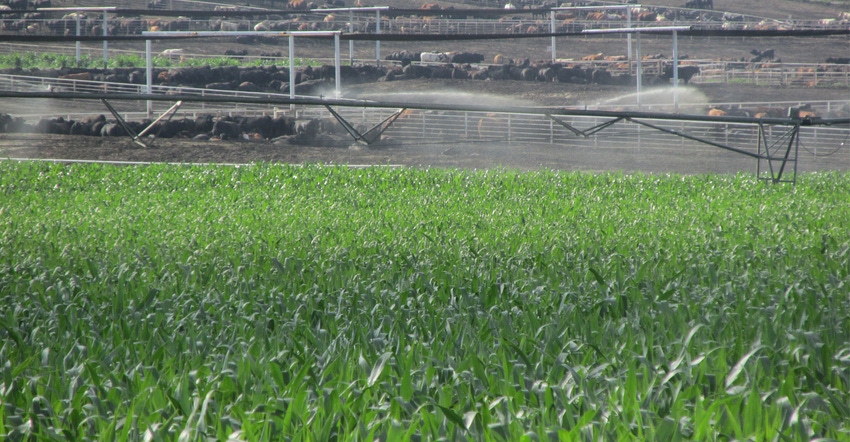July 3, 2018

By Rick Koelsch
The high rainfalls experienced in June have left many feedlot holding ponds full and operators looking for irrigation options to apply animal manure during the growing season.
Irrigated animal manure or effluent can replace commercial fertilizer, while maintaining or increasing crop yield. For example, a research team from Colorado State and Iowa State universities demonstrated that "sprinkler-applied swine effluent at the recommended agronomic rate resulted in maximum yields and minimal N accumulation below the crop root zone."
The study further noted that "applications of swine effluent at different times during the growing season appear to be effective … as no plant leaf burn was observed, even at high application rates."
Salt damage to crop tissue
Crop damage from sprinkler irrigation of manures with higher levels of electrical conductivity has been observed because of the direct contact of salts with plant tissue. Consider these factors:
• Knowledge of manure's salt concentration (or electrical conductivity) is essential. Measuring manure and effluent EC with a low-cost electrical conductivity meter (or laboratory test) is essential prior to application. Retired University of Nebraska-Lincoln soil scientist Charles Shapiro observed that liquid manure with an EC greater than 6 dS/m should not be applied to soybeans during early vegetative growth stages. Electrical conductivity below 12 dS/m was tolerated when the manure or effluent was applied at flowering. The Colorado State research cited above used swine lagoon effluent ranging from 4 to 5 dS/m on corn without concerns.
• Shapiro observed that corn was more tolerant than soybeans; damage in corn was only observed for an EC of 20 dS/m. Another researcher suggested that plant tissue susceptibility to injury varied according to crop and included the following, listed from least to greatest susceptibility: sugarbeets, cotton, barley, sorghum, alfalfa and potato.
• Plants at a later stage of growth are "less" susceptible to tissue damage from salts. As shared above, soybeans tolerate animal manure at flowering stage much better than in early vegetative stage. Shapiro observed that in corn, application at V8 with higher strength manure (20 dS/m) caused some yield loss. Corn leaf damage was observed when applied at V14 stage, but yield responded positively.
• Research has generally suggested that hot, dry, windy conditions producing high evapotranspiration rates increase the risk of plant tissue damage from manure irrigation.
Salts and soil salinity
Plants also can be damaged due to increases in soil salinity. Of greatest concern is a sudden increase in soil salinity that may occur in sandy soils with low buffering capacity when soil water in the root zone is depleted. If these conditions exist, manure application should be avoided.
In most Midwest conditions, saline soils are uncommon as sufficient rainfall occurs to flush accumulated salts from the root zone. Monitoring soil salinity during regular soil testing is a good check for potential concerns that might develop in low spots, areas with poor drainage, or from frequent repeated applications. Excellent information on managing soil salinity and crop tolerances is shared in a Colorado State Extension publication, Managing Saline Soils.
Best practices for protecting crops
When selecting a growing crop to receive irrigated manure or effluent, consider the following questions to help minimize your risk:
• What is the electrical conductivity of the manure being used? Manure with an EC of 6 dS/m or less should be acceptable for soybeans, while values of 12 dS/m or less should be acceptable for corn.
• If manure EC is higher than recommended, is fresh water available for dilution?
• Can application be delayed, or can it be applied on a more mature crop? The leaves on more mature plants are less permeable to salt absorption.
• Is there access to a hay crop that has been recently harvested with modest leaf growth to be damaged? Application to a recently harvested hay crop may be a preferred option.
• Can manure be applied at a time when evapotranspiration is lower? Evapotranspiration and risk of tissue damage is greatest during hot, dry, windy conditions. Application during evening or early morning should be more favorable.
• If applying to a sensitive crop or stage of growth, could manure application be quickly followed with a clean water rinse for the crop? Removing salts from leaf surfaces can minimize or prevent damage.
• Is there enough water storage in the soil profile to allow the applied effluent to infiltrate and avoid surface runoff?
Manures and runoff from feedlots can be valuable nutrient resources for applying to growing crops. Asking a few important questions about risks of salt damage to plant tissue can protect crops while maintaining animal manures as a positive crop resource.
For more information on irrigating with effluent, see Application of Liquid Animal Manures Using Center Pivot Irrigation Systems, EC778.
Koelsch is a livestock environmental engineer at the University of Nebraska-Lincoln. This report comes from UNL CropWatch.
You May Also Like




